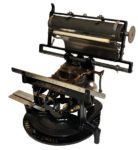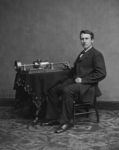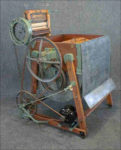Podcast: Play in new window | Embed
 This week in 1876 – Thomas Edison of Menlo Park, NJ patented the mimeograph machine. He described it as a method of preparing autographic stencils for printing. We don’t use mimeographs much these days, thanks to paper copiers and computers. The mimeograph worked by first creating a master which was placed on a large rotating drum. A purple ink would then print out on paper. Duplication has changed a lot in 140 years.
This week in 1876 – Thomas Edison of Menlo Park, NJ patented the mimeograph machine. He described it as a method of preparing autographic stencils for printing. We don’t use mimeographs much these days, thanks to paper copiers and computers. The mimeograph worked by first creating a master which was placed on a large rotating drum. A purple ink would then print out on paper. Duplication has changed a lot in 140 years.
Just one year later in 1877 – Edison finished figuring out his first phonograph. He handed the model of his invention to John Kreusi with instructions on how to build it. Kreusi bet the inventor $2 and said that there was no way that the machine would ever work. He lost the bet.
1896 – Harvey Hubbell of Bridgeport, CT received a patent for the pull-chain, electric-light socket! Pull the chain, the light goes on. Pull it again, the light goes off.
 1910 – Alva Fisher of Chicago, IL received a patent for an invention that moms, grandmas and single guys certainly came to appreciate: the electric washing machine. Previous to Fisher’s invention, washing machines were cranked by hand — or you used a washboard.
1910 – Alva Fisher of Chicago, IL received a patent for an invention that moms, grandmas and single guys certainly came to appreciate: the electric washing machine. Previous to Fisher’s invention, washing machines were cranked by hand — or you used a washboard.
1981 – IBM introduced the personal computer with their 5150 model. The IBM PC ran on the Intel 8088 microprocessor at 4.77 mHz. It had 16 kilobytes of memory, no built-in  clock or video capability — it was available however, with an optional color monitor. Prices started at around $1,500. The IBM PC was a smashing success and IBM quickly became the #1 microcomputer company, dropping Apple to #2. That was 35 years ago.
clock or video capability — it was available however, with an optional color monitor. Prices started at around $1,500. The IBM PC was a smashing success and IBM quickly became the #1 microcomputer company, dropping Apple to #2. That was 35 years ago.

